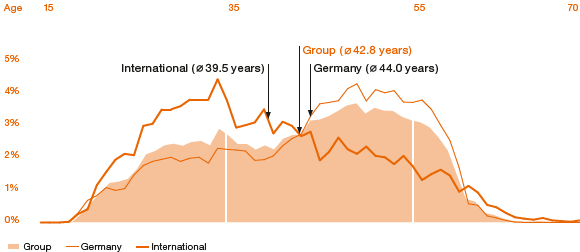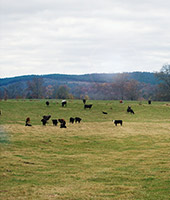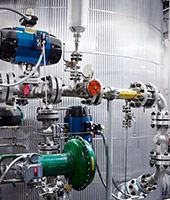Employees
Increase in Staff
WACKER’s workforce increased slightly in 2015. We had 16,972 employees worldwide as of December 31, 2015 (Dec. 31, 2014: 16,703), up 1.6 percent year over year. The major reasons for this growth were the increase in production at WACKER SILICONES sites outside Germany and the start-up of polysilicon production in Tennessee in the USA.
Siltronic continued to carry out its productivity measures in the reporting year. In Germany, the number of employees at Siltronic was reduced by 210 through intra-Group transfers, phased early retirement and voluntary severance packages.
Number of Employees at December 31, 2015
| Download XLS |
|
|
|
||||||||||||
|
2015 |
2014 |
2013 |
2012 |
2011 |
2010 |
2009 |
|||||||
|
|
|
|
|
|
|
|
|||||||
Germany |
12,251 |
12,366 |
12,322 |
12,635 |
12,813 |
12,235 |
11,925 |
|||||||
International |
4,721 |
4,337 |
3,687 |
3,657 |
4,355 |
4,079 |
3,693 |
|||||||
Group |
16,972 |
16,703 |
16,009 |
16,292 |
17,168 |
16,314 |
15,618 |
|||||||
|
|
|
|
|
|
|
|
|||||||
12,251 WACKER employees (72 percent) work in Germany and 4,721 employees (28 percent) at non-German sites. WACKER also employed 412 temporary workers in the year under review.
Number of Temporary Workers at December 31, 2015
| Download XLS |
|
|
|
||||||||||||
|
2015 |
2014 |
2013 |
2012 |
2011 |
2010 |
2009 |
|||||||
|
|
|
|
|
|
|
|
|||||||
Germany |
358 |
393 |
286 |
14 |
48 |
374 |
247 |
|||||||
International |
54 |
134 |
58 |
77 |
65 |
114 |
53 |
|||||||
Group |
412 |
527 |
344 |
91 |
113 |
488 |
300 |
|||||||
|
|
|
|
|
|
|
|
|||||||
As a manufacturing company, WACKER has a large contingent of industrial employees (54.1 percent), about a seventh of whom are women (13.4 percent).
Personnel expenses rose to € 1,350.1 million (2014: € 1,246.9 million), up 8.3 percent from the prior year. These expenses included outlays for social benefits and the company pension plan amounting to € 279.9 million (2014: € 238.8 million). The reasons for the rise in personnel expenses were the higher number of employees, the increase in the standard pay scale, and exchange-rate effects in the US-dollar area.
Personnel Expenses
| Download XLS |
|
|
|
||||||||||||
€ million |
2015 |
2014 |
2013 |
2012 |
2011 |
2010 |
2009 |
|||||||
|
|
|
|
|
|
|
|
|||||||
Personnel expenses |
1,350.1 |
1,246.9 |
1,133.0 |
1,196.8 |
1,282.5 |
1,135.7 |
1,090.3 |
|||||||
|
|
|
|
|
|
|
|
|||||||
In addition to their fixed base salary (which includes vacation and Christmas bonuses), WACKER employees usually also receive some variable compensation – a voluntary payment to employees on both the standard and above-standard pay scales. This payment comprises a profit-sharing amount and a personal-performance component. In 2015, WACKER’s chemical-sector employees in Germany received a profit share for 2014. Variable compensation payments totaled € 61.7 million groupwide in 2015.
The IG BCE labor union and chemical-industry employers agreed on a new 17-month collective-bargaining agreement in March 2015. The standard pay scale increased by 2.8 percent, and it was agreed to raise the demographic sum per standard-pay-scale employee to € 550 as of 2016 and to € 750 as of 2017.
A WACKER company pension is an important compensation component and is available at most of our German and non-German sites, except for regions where the statutory pension appears sufficient or legal provisions are inadequate. Wacker Chemie AG’s pension fund – Pensionskasse der Wacker Chemie VVaG – provides a company pension to WACKER employees in Germany. The fund has around 17,000 members and provides pension payments to some 8,000 retirees. The average pension paid was around € 640 per month. WACKER pays in up to four times its employees’ annual pension contributions, with the exact amount being determined by the type of agreement. Employees can supplement their company pensions by making their own additional contributions. WACKER matches supplementary contributions as provided for by the collective wage agreements. For the base amount, employees receive a 28-percent match called “Chemieförderung I”; additional contributions receive the 13-percent “Chemieförderung II” match. Employees in Germany also receive an additional supplementary pension for that portion of their salary which exceeds the pension insurance contribution assessment ceiling.
School Recruiting Efforts Intensified
In its personnel development activities, WACKER also relies on vocational training. In 2015, 178 young people began their training at WACKER or at the Burghausen Vocational Training Center (BBiW). In total, the company employed 597 trainees, slightly fewer than a year earlier (2014: 635). At 4.7 percent, the percentage of trainees (ratio of trainees to Group employees in Germany) is slightly below the previous year’s level (2014: 4.9 percent). 514 trainees are in scientific and technical disciplines and 83 in business-related fields. In 2015, WACKER offered jobs to the majority of suitable trainees -182 graduates – hiring 74 of them on temporary contracts and 108 on permanent contracts. The BBiW also provides training for 18 partner companies. The public foundation set up by WACKER thus satisfies an intercompany training mandate – in 2015, partner companies sent 55 trainees to start courses at the BBiW.
The high quality of the BBiW’s training is evidenced by all the awards won by its trainees. An electronics technician for automation technology received the Medallion for Excellence in the WorldSkills competition in Brazil. The Nünchritz site produced Saxony’s best chemical technician – for the fourth time in a row. The site was therefore named Outstanding Vocational Training Company for 2015 by the Dresden Chamber of Industry and Commerce.
WACKER will remain innovative and competitive as long as it has highly-skilled employees, which is why we offer all of our employees opportunities for additional training. At least once a year, employees and supervisors discuss development measures during performance reviews. This approach applies to all levels of the corporate hierarchy. In 2015, our employees completed about 66,000 e-learning sessions (2014: about 74,000), and more than 16,500 participants (2014: more than 16,400) attended seminars, advanced training programs and conventions, or received tutoring.
In 2015, we launched two new types of development programs for experienced managerial employees. The Learning Company seminar allows participants to assume different leadership roles as part of a model organization and obtain feedback on their performance from experienced instructors. During the External Peer Reflection program, our managers can exchange ideas with executives of the same hierarchical level from other companies.
In the reporting year, WACKER completed the second cycle of the talent-management process launched in 2013, culminating in the Executive Board conference on succession planning. The aim of talent management is to identify and encourage talent at an early stage, so that WACKER can fill challenging positions, too, with highly qualified in-house candidates in the medium and long term. In the reporting year, we surveyed the group targeted by talent management – above-standard pay scale employees and OFK executive personnel. Three-quarters of participants considered the process to be logical, and two-thirds felt the talent management goals were worthwhile.
Overall, WACKER invested € 7.7 million in personnel-development measures and advanced training in 2015 (2014: € 7.0 million).
WACKER Signs Diversity Charter and Implements Quota for Women
Globalization, demographic change and new regulatory requirements are making diversity and inclusion increasingly important issues. In 2015, WACKER started a groupwide initiative to promote diversity and inclusion in the workforce. The company joined the German nationwide Diversity Charter initiative. WACKER Germany is focusing on gender, age /experience and cultural background. People from 70 different nations work for WACKER. At the end of 2015, 41 of a total of 190 executive personnel groupwide were of non-German nationality – which corresponds to 22 percent of the total. Overall, 16 nationalities were represented at the executive level.
The German statute on equal opportunity for women and men in management that became law on May 1 has been implemented at WACKER as follows:
Executive Board: While Wacker Chemie AG attaches considerable importance to diversity as regards appointments to the Executive Board, expertise and qualifications remain the principal criteria for such appointments. In addition, there are no regular new appointments planned for the next available opening (June 30, 2017). Under these circumstances, the target for the proportion of women in the Executive Board for the period up to June 30, 2017, is zero.
Management levels below the Executive Board: WACKER is focusing its attention on the two levels of management below the Executive Board as depicted in the Wacker Chemie AG organizational chart. With regard to the second reporting level, we have also decided to include only managerial employees from the highest above-standard pay scale or those who are OFK executive personnel with responsibility for managing employees.
We have also designated the period up to June 30, 2017 as the reporting period for the two management levels below the Executive Board. Because our numbers are based on the status quo as of June 30, 2015, we will have a two-year period to observe developments.
Proportion of women: We aim to increase the proportion of women in the first level of management from 8 percent to 10 percent. For the second level of management, we have set a goal of raising the proportion of women from 14.5 percent to 17.5 percent. This goal is ambitious, given the fact that WACKER is a technology-oriented company. As a rule there are fewer women in the scientific-technical professions that are important to WACKER. Furthermore, there is very little staff turnover in Germany, and new appointments to the first and second levels of management are usually the result of employees going into retirement.
Employee Surveys at German Sites
WACKER conducted an inter-site employee survey in Germany in 2015. The goal was to identify the organization’s strengths and areas for potential improvement. The survey is also intended as a tool for assisting managerial employees in improving performance in their areas of responsibility. The evaluation of all German site results showed that WACKER employees identify with their employer to a large degree.
80 percent of the respondents are proud to work for WACKER and 82 percent would recommend WACKER as an employer. 78 percent are willing to exert themselves and carry out tasks above and beyond what is required of them to contribute toward the Group’s success. In addition, employees gave the Group a better-than-average rating for customer focus. 92 percent emphasized the fact that their tasks and what was expected of them were clearly defined. 90 percent responded that they are given work commensurate with their knowledge and abilities.
Employees felt that there was room for improvement regarding acknowledgment of their accomplishments, perceptions of appropriate compensation and opportunities for personal development. At the plants in particular, the employees expressed the wish to be included more in change processes and to learn together from mistakes.
Idea Management: Fewer Suggestions
The ideas submitted by WACKER’s employees help it to do things better and stay competitive. The number of employee suggestions decreased in 2015. In total, we received 7,429 suggestions (2014: 7,672), down by roughly 3 percent. The participation rate (number of submitters per 100 employees) also fell slightly to 29 percent (2014: 30 percent). The calculable benefit was € 6.8 million (2014: € 8.3 million).
Idea Management
| Download XLS |
|
|
|
||||||||||||
|
2015 |
2014 |
2013 |
2012 |
2011 |
2010 |
2009 |
|||||||
|
|
|
|
|
|
|
|
|||||||
Number of improvement suggestions |
7,429 |
7,672 |
9,159 |
8,982 |
8,220 |
7,702 |
5,724 |
|||||||
Participation rate (%) |
29 |
30 |
32 |
34 |
34 |
33 |
28 |
|||||||
Calculable benefit (€ million) |
6.8 |
8.3 |
7.7 |
4.9 |
7.8 |
10.5 |
11.2 |
|||||||
|
|
|
|
|
|
|
|
|||||||
WACKER has been addressing demographic change for many years. The average age of the Group’s workforce at the reporting date was 42.8. Employees at non-German sites are younger (average age: 39.5) than in Germany (44.0). The age structure abroad varies greatly from region to region. Staff at Asian sites are comparatively young (average age: 34.8), while staff at US locations have an average age of 45.3. Regional variations in age structure are not exclusive to WACKER; they reflect the age structures of the populations in the respective continent or country.
Demographic Analysis of German and International Sites in 2015

Health Management Continues to Focus on Back Health
To maintain WACKER’s long-term innovative and competitive strength, we have set ten strategic goals. Long-term measures for the workforce range from training opportunities to health programs. WACKER’s health management program focuses on five fields. Our goal is to prevent spinal disorders and cardiovascular diseases in our workforce, increase mental resilience, ensure that tasks are age-appropriate and find suitable jobs for staff with health restrictions. In 2015, Health Services continued the groupwide initiative for back health it had initiated in the previous year. This campaign aims to raise awareness and introduce prevention programs. At WACKER, back problems are the leading cause of sick days.
In 2015, the Fit for Your Shift project included Siltronic AG employees for the first time. In this health program tailored to shift workers, participants are taught habits that can help them deal better with the pressures of shift work in the long term. The evaluation of two years of practical experience demonstrated that participants reduced risk factors such as being overweight and improved their fitness and quality of sleep.
WACKER initiated the Health Culture 2020 program in Germany, with the aim of improving the long-term health of its employees, ensuring that they remain fit for work and thus reducing days of work missed due to illness. The main emphasis of the project is to strengthen our employees’ sense of responsibility for their own health and to assist managers in stewardship of their resources and promoting healthy behavior in their employees.
At our main site in Burghausen, we opened a new health center: a modern, efficient facility for providing occupational and emergency medical care to about 10,000 employees.
Good social benefits, competitive compensation and motivating tasks make WACKER an attractive employer. This explains our high level of employee loyalty. The average length of service in Germany (permanent staff) was 18.4 years (2014: 18.1 years). In 2015, the groupwide employee turnover rate remained virtually constant at 4.6 percent (2014: 4.1 percent), while in Germany it was only 1.1 percent (2014: 0.8 percent). At non-German sites, the rate was 14.6 percent (2014: 13.8 percent).
Employee Turnover Rate
| Download XLS |
|
|
|
||||||||||||||||
% |
2015 |
2014 |
2013 |
2012 |
2011 |
20102 |
2009 |
|||||||||||
|
|
|
|
|
|
|
|
|||||||||||
|
||||||||||||||||||
Germany |
1.1 |
0.8 |
0.9 |
0.9 |
0.9 |
0.6 |
0.7 |
|||||||||||
International |
14.6 |
13.8 |
11.9 |
30.81 |
8.9 |
8.7 |
8.6 |
|||||||||||
Group |
4.6 |
4.1 |
3.4 |
7.9 |
2.9 |
2.5 |
2.5 |
|||||||||||
|
|
|
|
|
|
|
|
|||||||||||
A Popular Employer Among Managers
As viewed by its own managerial employees, WACKER was once again one of the most popular chemical-sector employers in Germany in 2015. In the annual satisfaction survey conducted by Germany’s Association of Chemical-Industry Executives (VAA), Wacker Chemie AG returned to the top ten of German chemical and pharmaceutical companies. WACKER ranked eighth with a score of 2.9 (with 1 being the highest and 5 the lowest), up from twelfth place in 2014, and performed above the average grade of 3.1 that managerial employees from 23 companies gave their respective employers.




